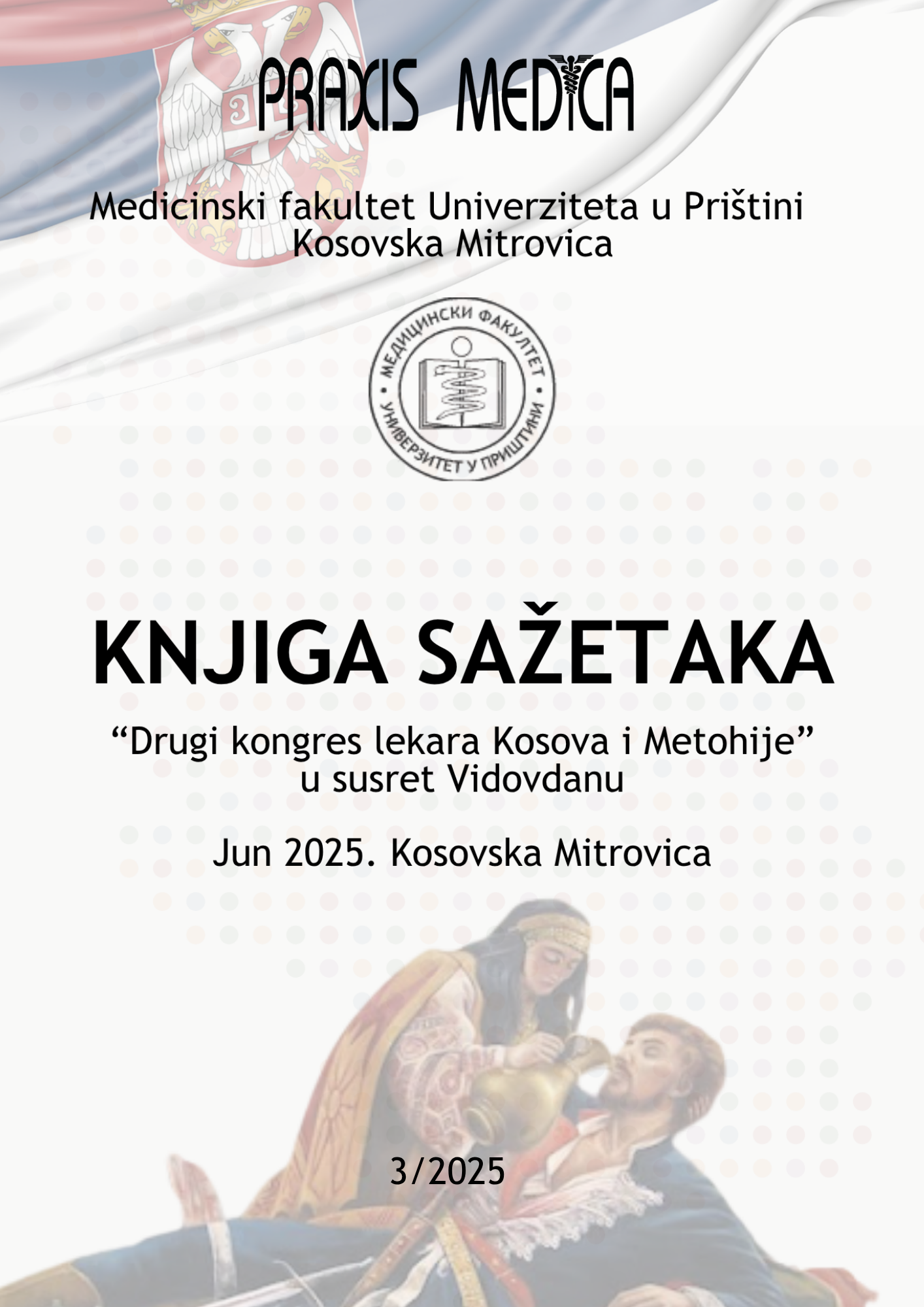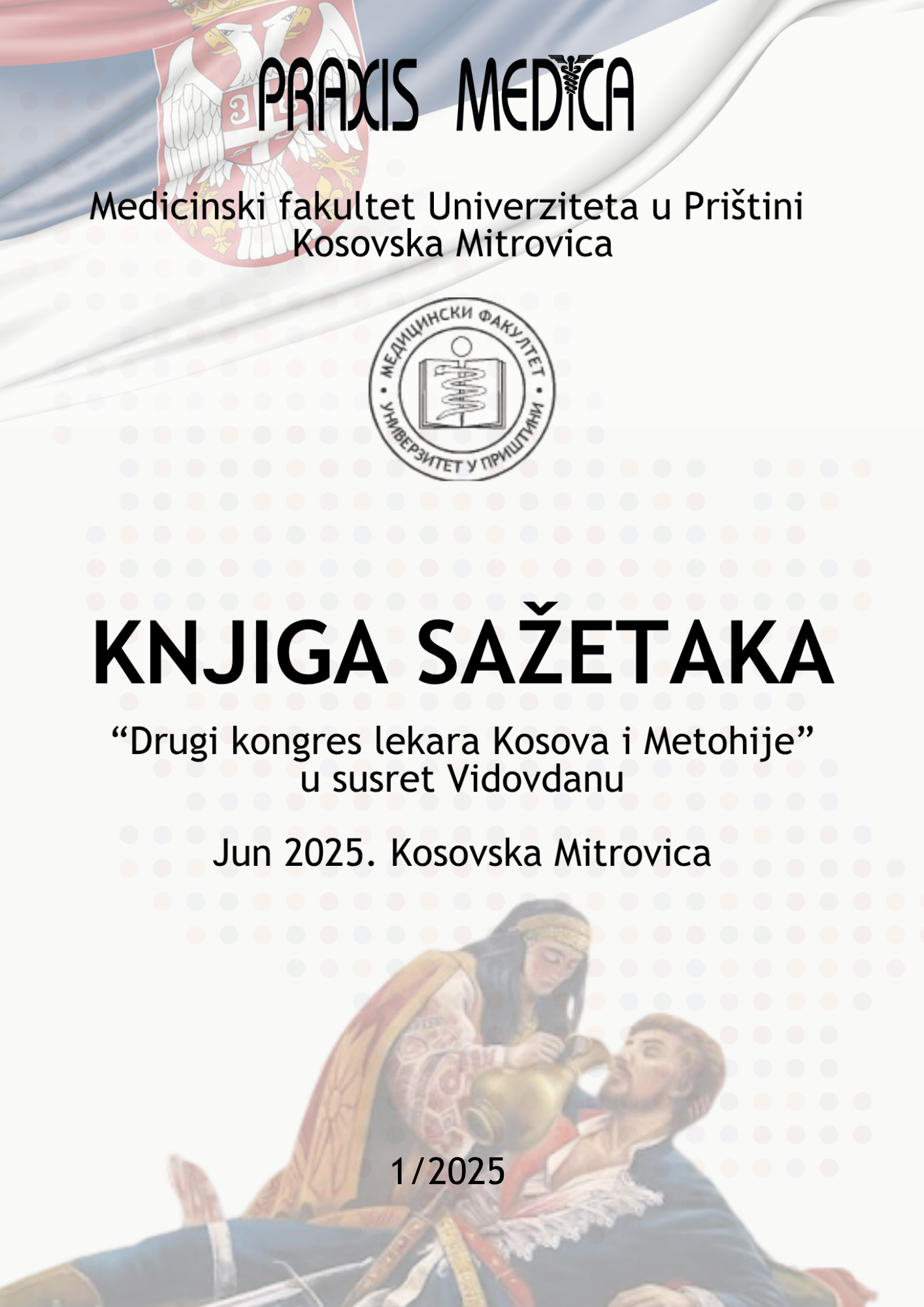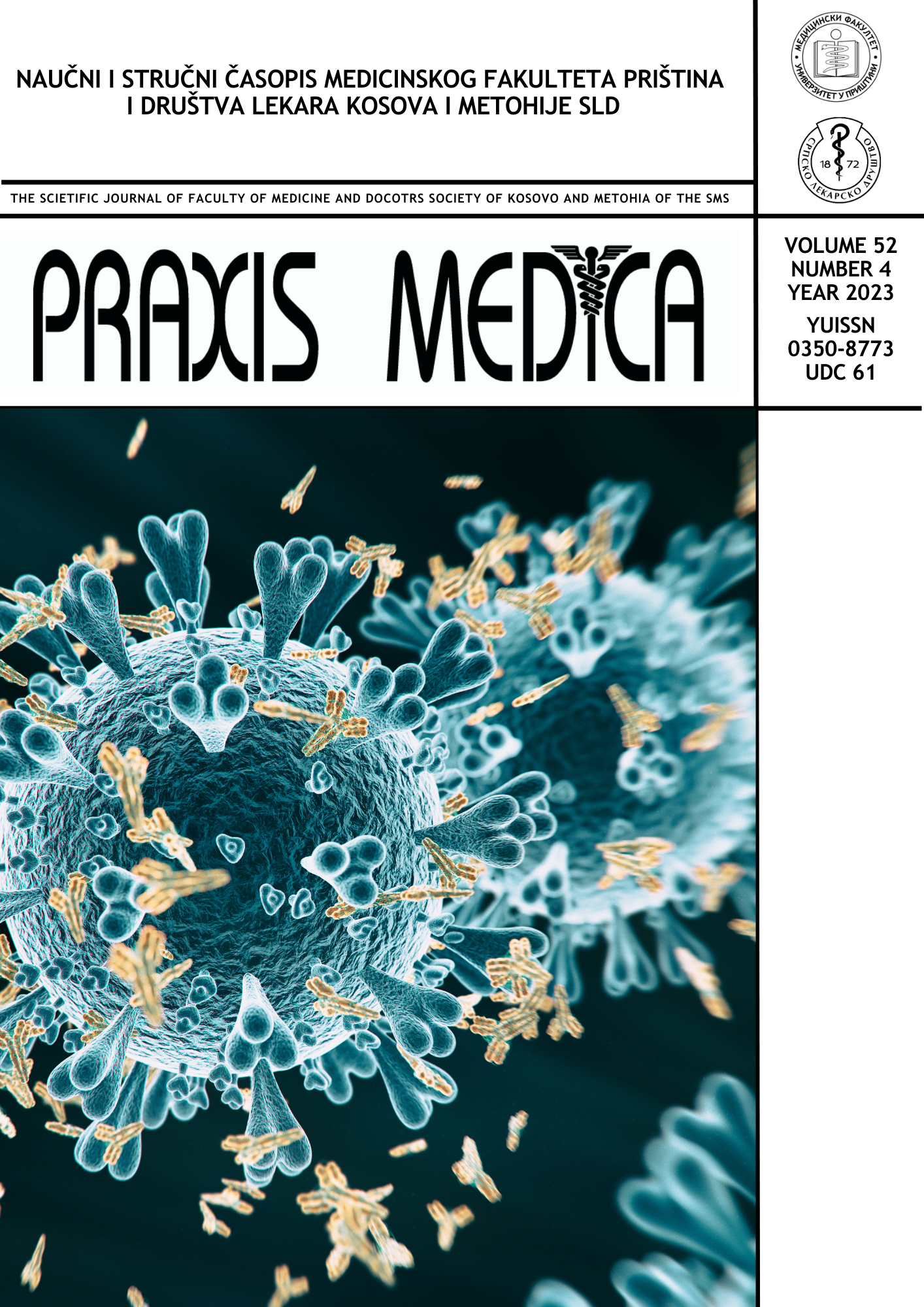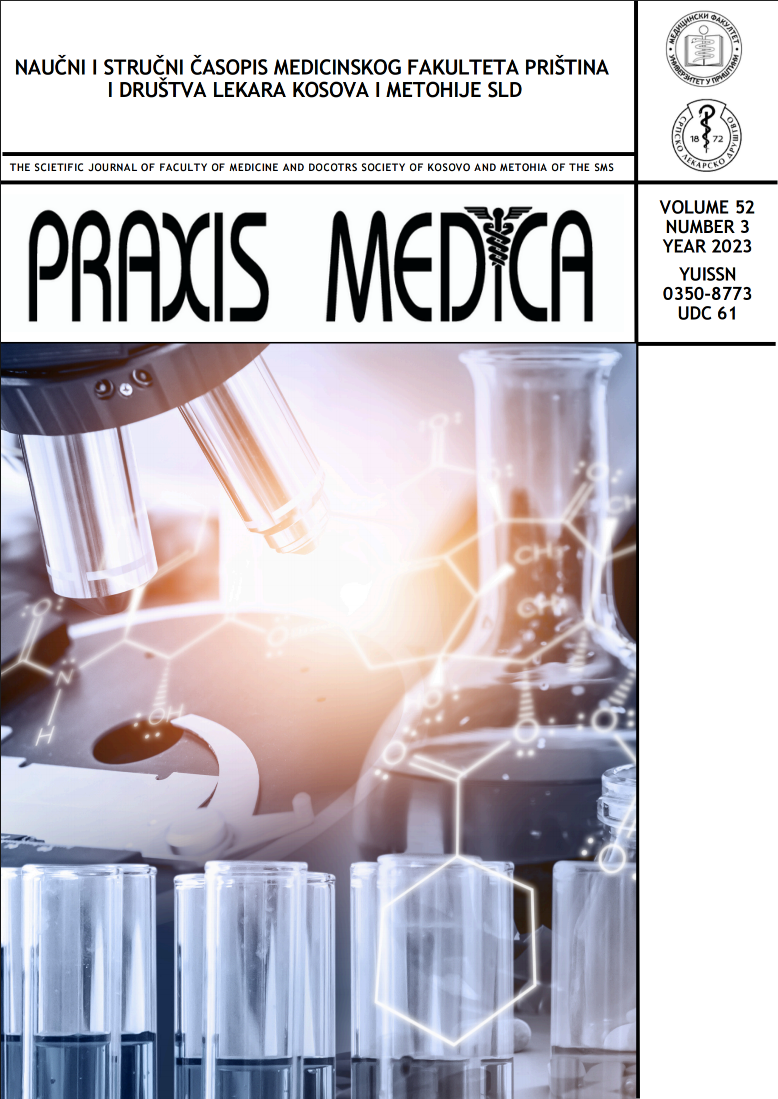Current issue

Volume 53, Issue 4, 2025
Online ISSN: 2560-3310
ISSN: 0350-8773
Volume 53 , Issue 4, (2025)
Published: 30.06.2025.
Open Access
All issues
Contents
01.01.2006.
Professional paper
INITIAL RESULTS OF BICARBONATE HAEMODIALYSIS TREATMENT IN DIALYSIS CENTER IN KOSOVSKA MITROVICA INITIAL RESULTS OF BICARBONATE HAEMODIALYSIS TREATMENT IN DIALYSIS CENTER IN KOSOVSKA MITROVICA
Haemodialysis, as a drastic medical procedure, needs a modern technology for performing of qualitative depurative process. Trying to imitate a function of healthy kidneys, it provides survival without one vital organ. The aim of the study was a qualitative estimation by comparing laboratory and clinical parameters of one-year haemodialysis treatment with different dialysis methods. In all patients treated with chronicle haemodialysis in Dialysis Centre in Kosovaska Mitrovica, we performed a set of laboratory analyses, recorded hepatotrophic viruses and determined a quality of haemodialysis by the degree of urea elimination. There are 16 patients on chronicle haemodialysis, 11 female (68,75%) and 5 male (31,25); mean age, 52,46±16,89 years, mean time on dialysis was 58±51,835. An increase of hemoglobin concentration was correlated with bicarbonate heamodialysis initiation. (61,692±19,405 vs. 75.466±13,814; p=0,038). Cholesterol (5,32±1,522 vs. 4,34± 1,006; p=0,0481) and inorganic phosphorus (1,427±0,2327 vs. 1,692±0,260; p=0,0056) are biochemical factors that are in a reverse correlation with bicarbonate haemodialysis in our patients. The degree of urea elimination as a measure for haemodialysis adequacy was statistically significant indicator of an adequate dialysis and was correlated with bicarbonate haemodialysis initiation (t=8,571; df=1; p=0,0389)
R. Stolić, S. Radosavljević, A. Jovanović, V. Perić, S. Sovtić, D. Stolić, T. Novaković, G. Šubarić-Gorgieva
01.01.2006.
Professional paper
HERNIAOFINGUINALREGION AND THEIR SURGICALTREATMENT
Ahernia occurs when the contents of a body cavity bulge out of the area where they are normally contained. These contents, usually portions of intestine or abdominal fatty tissue, are often enclosed in the thin membrane that naturally lines the inside of the cavity. Although the term hernia can be used for bulges in other areas, it most often is used to describe hernias of the lower torso (abdominal wall hernias). Hernias by themselves usually are harmless, but nearly all have a potential risk of having their blood supply cut off (becoming strangulated). If the hernia sac contents have their blood supply cut off at the hernia opening in the abdominal wall, it becomes a medical and surgical emergency. Aims of the paper were: 1. to reveal the prevalence of inguinal region hernias (IRH) among all patients being admitted to emergency ward of Surgery Clinic at Gracanica during 2006 and 2. to show treatment efficacy of each surgical methods used. Material and method: Clinical
Center Pristine, Surgery Clinic at Gracanica patients' medical records were analyzed. Prevalence of IRH was monitored during the time frame of 1 year (2006). Basic statistical methods were applied for data analyzing. Results and discussion: During the time observed, 504 patients underwent surgical treatment. Among them, 162 patients (32,14%) were operated on inguinal region hernias. IRHs were more prevalent in males - 146 cases (90,12%) in comparison to 16 cases in females
(9,88%). During the certain time period, IRHs were more prevalent in adults 101 cases (62,35%) than in children 61 cases (37,65%). The vast majority of all operated hernias, belong to group of inguinal hernias 156 cases (96,30%). At the same time, there were only 6 cases (3,70%) of femoral hernias. This observation is in concordance with the data published worldwide inguinal hernias make up 75% of all abdominal wall hernias and occur up to 25 times more often in men than women.
The study, also, revealed incarcerated hernia (part of the intestine or abdominal tissue that becomes trapped in the sac of a hernia) in 6 patients (3,70%) while recurrent hernia was found in 3 patients (1,85%). The most frequently used surgical approaches were: i) Ferrary method in 54 patients (33,33%; ii) Lichtenstein method in 42 patients (25,93%), and iii) Bassini method in 35 patients (22,22%). Postoperative complications were noted in 3 patients (1,85%). Conclusion: Based on the results obtained, one may conclude that efficacy of surgical method used in treatment of IRH is in indirect relation with the number of postoperative recidives the higher the number of hernia recurrences, the lower the efficacy of surgical method is
J. Mladenović, N. Videnović, D. Perić, M. Stanišić, A. Hodža, S. Mladenović, R. Mladenović, S. Aranđelović, A. Sekulić
01.01.2006.
Professional paper
UTERUS FACTOR AS A REASON OF REASON OF INFERTILITY OF THE WOMAN
The tests were made at deparment of infertility at the Gynecology and Obstretics Institute of Clinical Center of Serbia in the period from 01.01. untill 31.12.1998. The three hundred patients, on which hysterosalpingography (HSG) was made, and patients, on which chromolaparoscopy was made, were involved by prospectus studies. In the laparoscopy the larger anomalies of the uterus and significant hypoplasy coincide with HSG finding, while hypoplasy in the lower level or uterus arcuatus always can not be established by laparoscopy.The higher frequency of all pathological alterations of the uterus, except the myoma of the uterus, was established by HSG, relating to laparoscopy. Associate pathological alterations were established in the higher percent by HSG than by the laparoscopy, while the single changes were diagnosed in the lower percent.The deficit in the loading of the uterus by the constrast medium, also the changes at the endometrium, could be proved by HSG only. Intravasation can be identified by the both methods. In the diagnosis of the myoma of the uterus, laparoscopy is more important method than HSG.Pathological alterations of the uterus, especially higher anomalies of the uterus and hypoplasy were established in the higher percent by HSG than by the laparoscopy, but statistically the more significant difference was not established in the application of the both methods
B. Stanojević, Lj. Vojvodić, M. Bogavac
01.01.2006.
Professional paper
THE NATALITY OF SERBS IN KOSOV SERBS IN KOSOVO AND MET AND METOHIJA
The birthrate in Serbia has been falling and we are the last country in Europe according the number of newborn children. The aim of this study was to establish the birthrate trend during the period of five years on the territory of Central Kosovo and Metohija, according the data of Gynecology- Obstetrics Clinic/Gracanica, to indicate the importance of an improvement of women's health care, increase the birthrate and population growth rate. There was used a retrospective method of examination of the data from the maternity hospital register in Gracanica. There were also used the data from the death registry in the local community of Donja Gusterica and the records of students enrolled into the first grade of Primary School in Donja Gusterica. During the period from March 2002 to August 2005 there were born 1718 children (912 boys and 806 girls). There is almost no family on this territory with less than three children and there is a significant number of families with four or five children. The number of women who bore six times was 24, seven times was 13 and eight times was 11 while there were two women who born the ninth child and one woman who bore the eleventh child. During the five-year period, on the territory of local community of Donja Gusterica, there died 169 people while, at the same time, the number of students enrolled into the first grade of primary School was 293. An important contribution to growth of natality is an improvement of the women's health care. There was noticed a constant increase in number of newborn children for the mentioned period as well as a significant increase in population growth rate in Central Kosmet
R. Perenić, R. Stolić, S. Kapetanović, D. Stolić
01.01.2006.
Professional paper
THE INFLUENCE OF KALIUM LEVEL FOR BEGINING CARDIAC ARRHYTMIAS IN PATIENTS WITH ACUTE MYOCARDIAL INFARCTION
Hypokaliaemia can be cause for beginning cardiac arrhythmias in patients with acute myocardial infarction. The aim of this investigation is to determine correlation between kalium level in serum and cardiac arrhythmias and conveying, to note down in first 24 hours in patients with acute myocardial infarction (AMI). Patients in this study attended in department of Internal medicine(coronary department ) in hospital in Health center in Kosovska Mitrovica.In this prospective study for one years we analyzed 110 patients with diagnosis of acute myocardial infarction. We found that cardiac arrhythmias represented in the most noumber of patients in the first 24 hours from receiving in hospital- 83,63%.The patients have had the more noumber of complex VES(20,91%),SVT(18,18%) than other cardiac arrhythmias in the first 24 hours from their received in the hospital. The low level of kalium have note down in 9,09% patients. The comlex VES have represented in patients with low level of kalium as VF. In the presence of kalium level under the 4,0 the risk for ventricular arrhythmias is higher.SVT have had in 20% patients with acute myocardial infarction,SVB in 10%,SVES in 16%,VF in 7% patients with normal kalium level in serum as branch block and AV-block I, II, III degree. Hypokaliaemia have influence on represence of VES and VF, but have not influence on represence of supraventricular arrhythmias and the disorders of conveying.
N. Vujačić
01.01.2006.
Professional paper
THE STRUCTURE AND FUNCTION OF DENDRITIC CELLS
Dendritic cells (DCs) are antigen presenting cells which trace origin from bone marrow cells. These cells are discovered and described by Steinman i Cohn (1973) in peripheral lymphoid organs of mice. The cellular membrane of DCs are place of expression of plenty immunoregulatory molecules such as MHC class I and II, co stimulatory, and adhesion molecules, as well as many receptors for different cytokines. Armed on this way, DCs are one of the most effective antigen presenting and immunoregulatory cells. Moreover, role of DCs in development of immune reaction can be crucial due to they are one of the most important cellular “link” between native and adaptive immunity. DCs are engaged in mechanisms of antigen processing and presentation, induction of immune reaction, establishing immune tolerance and immune reaction regulation, balancing the immune reaction between autodestruction and protection of “self” cells. These functions makes that DCs play very important role in development of some pathological conditions and diseases such as autoimmunity, allergies and quality of anti-tumor and anti-microbe defense. Unbalanced immune reaction is hallmark of all cited diseases and immunopatological conditions, so that the function of DCs should be explored on the better way.
Z. Anðelković, S. Leštarević, N.B. Mitić, I. Bubanović, D. Marjanović
01.01.2006.
Original scientific paper
CORRELATION BETWEEN COLPOSCOPICAL AND HISTOPATOLOGICAL FINDINGS AT CARCINOMA PVU
Of 130 examined women who had not undergone a cytological and colposcopy check-up for at least a year, there were positive colposcopy: mosaic 39 (30,00 %), atipic vascularisation 15 (11,54 %) and suspect of invasive cervical cancer 1 (0,77 %). While the invasive carcinoma was ascertained most frequently at the ages of 40 to 59. The frequent incidence of severe displasia in subjects is 2,31 %, microinvasive cervical cancer 1,45 %, and the incidence of the invasive carcinoma is 3,85%.
S. Cvetkoviċ, B. Petrović, S. Stanišić, N. Milinčić, N. Stanišić
01.01.2006.
Original scientific paper
FEAR OF ADOLESCENTS ADOLESCENTS FROM STOMATOLOGICAL OLOGICAL INTERVENTIONS
By this investigation an attempt has been done to explain the existence of fear in adolescents from stomatological treatment, by appraisal of fear through its two components (congenitive and physiological). Congenitive component of fear,
was followed by written questionnaire before the first stomatologic intervention (by the standard scale of general anxiety). In the investigation participated 100 adolescents. On the basis of analysis of the question mark the adolescents have been
placed into three groups: normal, pathological and increasingly anxious. During third visit (three stomatologic interventions) each patient was recived the placebo (vitamin C one half of the tablet, orally, 30 minutes before start of work of stomatology interventions which were identical, i.e. the sanitation of deep carries). Physiological component (sweating and voice) have been appraised by the method of clinical observation. All parameters were measured before all three stomatologic interventions. In this investigation, in parameters measured by clinical observation happened a diminution of strong small of sweating, trembling voice stammering in occasion of application of placebo therapy
D. Popović-Babić, V. Ivetić, M. Apostolović, N. Naumović, B. Biskupljanin
01.01.2006.
Original scientific paper
SYMPTOMS, SIGNS AND ABNORMAL CLINICALAND LABORATORY FINDINGS IN WORKERS IN THE CHLORINE-ALKALI ELECTROLYZE
Elementary mercury using as cathode in process chlorine-alkali electrolyze. Mercury vapor makes in process going in work setting atmosphere. Aim of the work is to examine whether symptoms, signs and abnormal clinical and laboratory findings are in the correlation with work in the chlorine-alkali electrolyze. Examination of air pollution work setting discovers that the major factor of air pollution is mercury vapor. On periodical view at 2000, 2002 and 2004 year was examine 571 respondent, and their diagnosis was entered in report, from which was separated symptoms, signs and abnormal clinical and laboratory findings. Workers on different workplaces are exposes in different degrees. Examinees were divided in a four group according to the grade of exposure: I group day by day exposed; II group sporadically exposed; III group earlier exposed; IV group not exposed. I, II and III group are workers which work in the process chlorine-alkali electrolyze. IV group was control group and her compose administration personal. The statistical testing differences of frequency between groups according to the grade of exposure is showed there is statistical significantly difference between I and III, and II and IV groups. We are concludes that symptoms, signs and abnormal clinical and laboratory findings, statistically significantly, there is in persons which are permanently and long term worked in the chlorine-alkali electrolyze setting, from persons which are not permanently expose or nonexpose
A. Ćorac, G. Trajković, M. Mirković, P. Kuzmanović, M. Vukotić, S. Samardžić, V. Mišolić
01.01.2006.
Original scientific paper
DIABETES MELLITUS, RISK FAKTOR FOR CANDIDA SKIN INFECTION
Diabetes mellitus is a typical example for connection betwen sickness of internal organs and the skin. The ratio betwen glycose level in a gram of skin and the amount of glycose in a mililiter of blood is higher in diabetes mellitus then normal. This implies that insulin regulates intracelular distribution of glycose in the skin. It is recessary for the keratinocyt growth and diferentiation, healing of wounds, but also for the fibroblast functioning in the derm. In diabetes mellitus acidofil is lowered, and glycolised colagen is increased, and fibroblasts in the extra produce fibronectin. Skin and visible mucosys infections caused by candida albicans in diabetes patients belong to the group of deseases that could be a consequence of a disbalanced metabolism. They are seen frequently, but not patognomic for these patients, becuse they are also possible in people whose metabolism is normal. Badly controlled or undiagnosed dibetes mellitus is often coupled with candida induced skin deseases. Sometimes candida infections are the first sign of diabetes. Dermatologist is often in position to discover the disease on the basis of skin symptoms, which gives possibility for regulation of the sickness on time and avoid complications. It is known that complications develop slower when diabetes is regulated. Skin alterations in candidiasys and its connection with diabetes are described briefly, with an attempl to explain patogenesys of their apearence.
Z. Sojević, T. Novaković, D. Staletović











